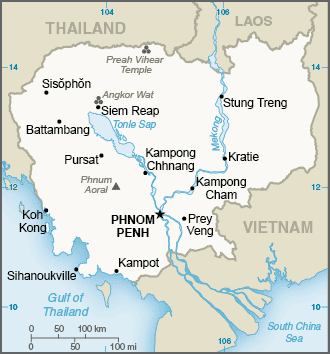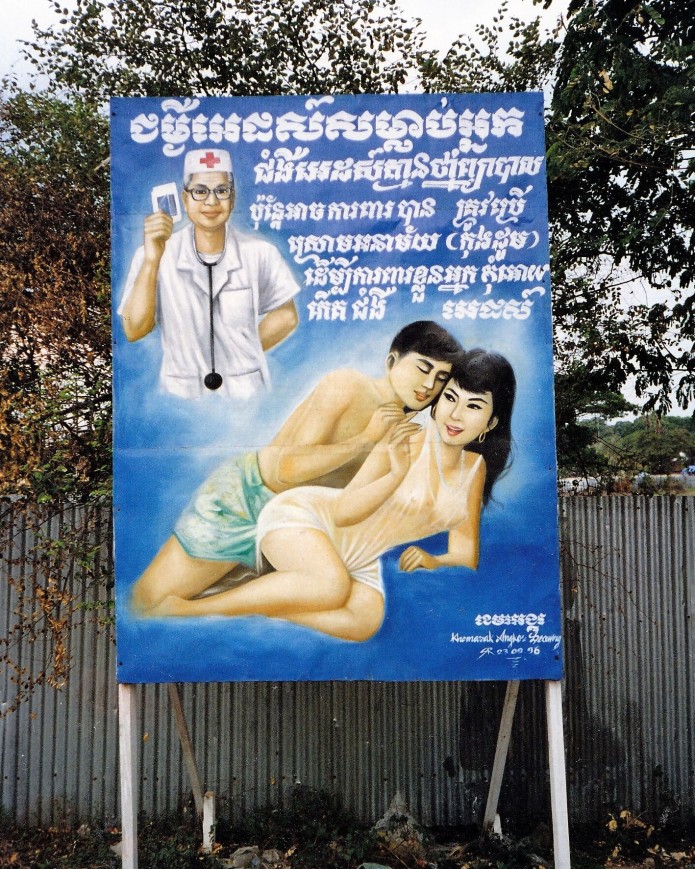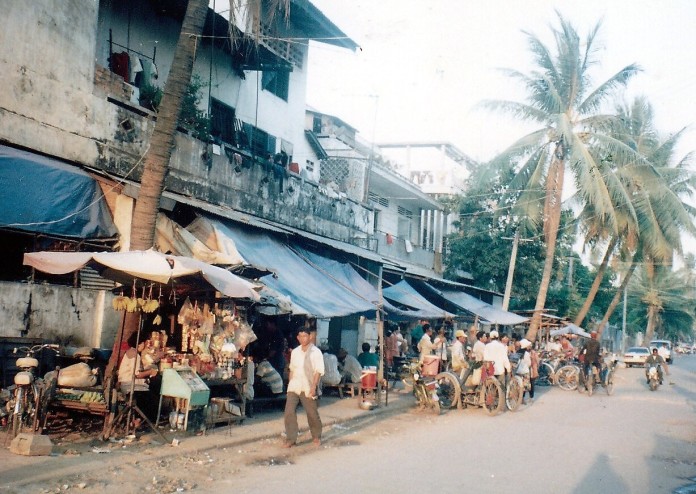December 1996:“A weekend retreat — traveling three hours by convoy for safety, radios in each of the three cars and along a good, tar-sealed road (which passes through Pol Pot territory – and a popular kidnapping area lined on either side with mine fields) brings us to some very pleasant beaches along Cambodia’s southern coast. Then, during a morning jog along the beach, someone discovered a freshly killed, bloody corpse (probably a smuggler) the day we left the resort town Kompong Som. A stark reminder that we are still in Cambodia – where at times life can seem cheap, and security must be taken seriously.”
In May 1996, I moved to Phnom Penh, Cambodia to set up and manage UNICEF’s country program assistance to government, NGOs and international organizations as part of the Mekong Region STD/HIV/AIDS Project, a new regional project implemented in six countries bordering the Mekong River: Cambodia, China, Laos, Myanmar, Thailand and Vietnam.

Still reeling in the aftermath of the Khmer Rouge’s reign of terror (1975-1979) that resulted in the deaths of up to three million people or nearly a quarter of the 1975 population through execution, torture, starvation, and disease. Tragically, in the mid-1990’s Cambodia was experiencing the most serious and rapidly progressing HIV/AIDS epidemic in Asia, and was on the brink of becoming one of the worst affected countries in the world.

For the majority of Cambodians, HIV/AIDS was not considered a priority concern. Disruption and weakening of the family and community, as well as continued armed conflict and extensive poverty following years of turmoil had resulted in large numbers of young people, women and children living in especially difficult circumstances.

The rapid transition to a free market economy, increased population mobility, the opening of borders, and other liberalizing measures implemented with little apparent guidance or regulation were also contributing to the explosive spread of HIV in Cambodia.

The primary mode of HIV transmission was unprotected heterosexual intercourse. Women especially faced an enormous challenge from HIV. National HIV Sentinel Surveillance had found that over 40% of the commercial sex-workers tested and nearly 2% of pregnant women attending ante-natal clinics were HIV-infected.

Even among those who were not occupationally exposed in Cambodia’s growing commercial sex industry, women were increasingly at risk for infection from their husbands and boyfriends.
UNICEF’s chief strategy was to raise the capacity of counterpart organizations at local levels, working in collaboration with target populations assessed to be most vulnerable to sexually transmitted diseases (STDs) including HIV.

These included students in primary, secondary and vocational schools, non-formal education participants, out-of-school youth, women of reproductive age, and women and children directly affected by HIV and AIDS – especially rural people and ethnic minorities who faced a higher risk for HIV infection because of their marginal status.

Because so many of the educated Khmer had either died, were badly traumatized, or had fled the country to escape the horrors carried out by the Khmer Rouge under Pol Pot, the few remaining qualified government counterparts UNICEF could work with were stretched to the limit and often unavailable as they faced enormous challenges of competing priorities in health, education, social welfare, and other sectors that UNICEF supported.
Project Officer for STD/HIV/AIDS
As UNICEF’s Project Officer for STD/HIV/AIDS, I was responsible for the planning, development and management of technical and financial assistance on all aspects of Project implementation to establish Cambodia’s component of UNICEF’s Mekong Region STD/HIV/AIDS Project.

Through on-going situation analysis, awareness-raising, human resource needs assessment and training, the Project raised the capacity of government agencies, NGOs, local communities and the UNICEF country office to design, test, implement, monitor and evaluate activities to reduce HIV/AIDS transmission and increase community acceptance and care for women, children and families affected by the illness.
As the leading multilateral agency supporting Cambodia’s National HIV/AIDS Program and its multiple implementing partners at national, provincial and community levels, a major challenge was coordinating these important and wide-ranging efforts for maximum impact.

A swim each evening at the International Youth Club pool was refreshing and helped ease the strain, followed by a bowl of noodle soup from my favorite street vendor and a loaf of hot, crispy French bread from the ‘Nom Pang’ (bread) vendor whose ‘Pang Pang’ cries echoed through the streets as he peddled his bike through the night.

Of course, it was prudent, especially after dark, to carry a readily accessible $20 bill to hand off in a hurry if confronted by armed robbers roaming the streets.

Once known as the “Pearl of Asia,” Phnom Penh was considered one of the loveliest French-built cities in Indochina in the 1920’s. Sadly, in the mid-90’s, the city was a stinking mudslide when it rained, and a heavily trashed dust bowl the rest of the time, especially because of the growing traffic on the largely unpaved roads.

Of course, a big challenge was simply managing the energy drain and overall depressing nature of the place. Rampant corruption, civil war and subsequent political purges, AIDS, poor illiterate peasants, beggars, amputees, child prostitution, orphans – it was going to take time to recover from such horrific trauma and suffering.

Strolling home from the pool each night under the stars, twinkling through the coconut palms – down the quiet, dusty back streets, a few fires burning in the darkness, migrant workers and their families huddled in ramshackle shelters.
A few guys shooting snooker, a scuttering rat or two in the rotting rubbish piles and stagnant pools of stinking water, past a small market area behind the crumbling hospital next to a temple. But as usual, there was not much worth buying or eating – except a roast banana or perhaps a blackened, rock-hard baguette from the mobile hot bread-seller.

Again, the positive and stimulating nature of my work at UNICEF is what saved me. Grateful for the pool, for quiet, walkable streets with (at that time) only limited motorized traffic, and the stamina to respond to the swarms of kids desperately seeking attention and love – and yet somehow, still bursting with boundless youthful exuberance.
Stay tuned for Part Two, coming soon!
You can read more about Jim’s backstory, here and here.

